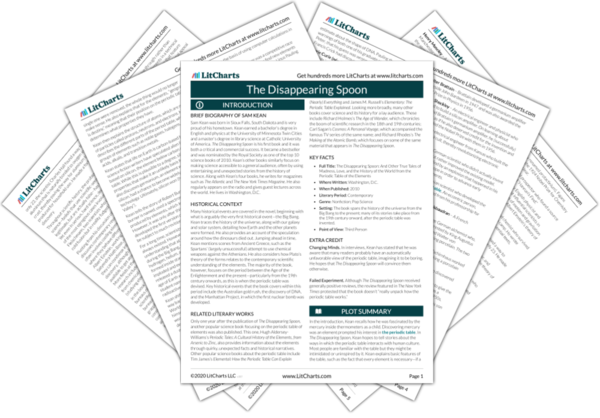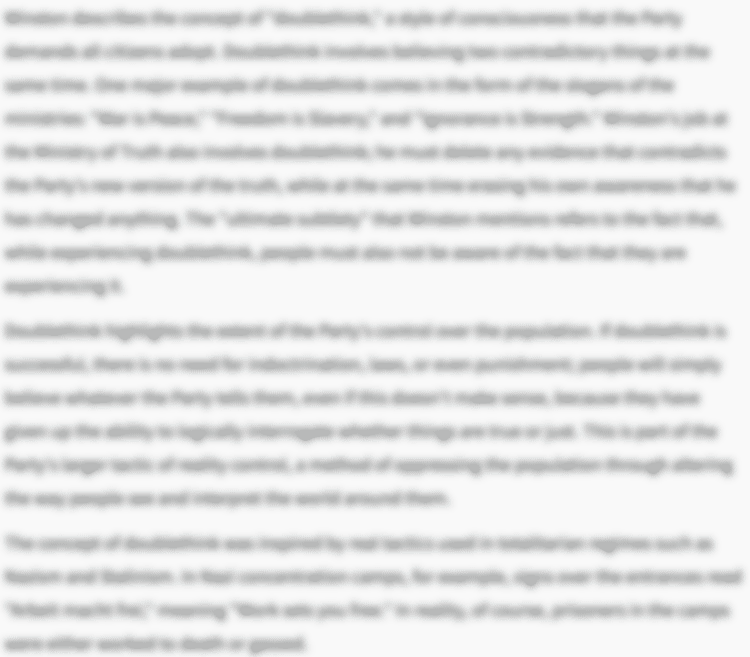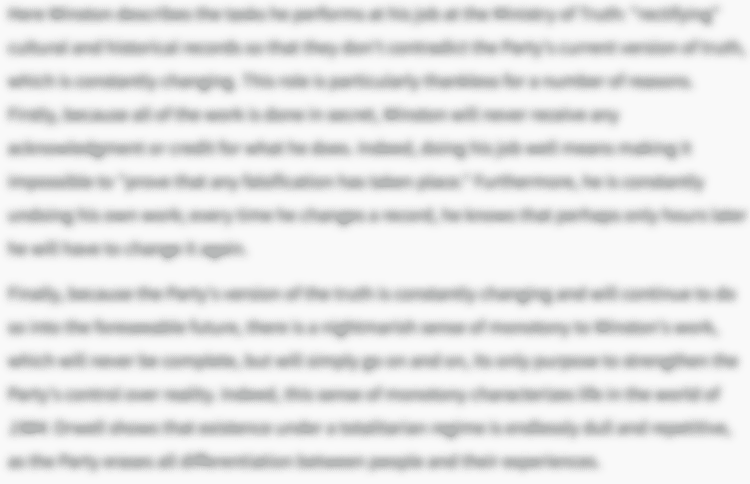I latched on to those tales, and recently, while reminiscing about mercury over breakfast, I realized that there’s a funny, or odd, or chilling tale attached to every element on the periodic table. At the same time, the table is one of the great intellectual achievements of humankind. It’s both a scientific accomplishment and a storybook, and I wrote this book to peel back all of its layers one by one, like the transparencies in an anatomy textbook that tell the same story at different depths.

Unlock explanations and citation info for this and every other The Disappearing Spoon quote.
Plus so much more...
Get LitCharts A+The periodic table is, finally, an anthropological marvel, a human artifact that reflects all of the wonderful and artful and ugly aspects of human beings and how we interact with the physical world—the history of our species written in a compact and elegant script.

People are used to reading from left to right (or right to left) in virtually every human language, but reading the periodic table up and down, column by column, as in some forms of Japanese, is actually more significant. Doing so reveals a rich subtext of relationships among elements, including unexpected rivalries and antagonisms. The periodic table has its own grammar, and reading between its lines reveals whole new stories.
The discovery of eka-aluminium, now known as gallium, raises the question of what really drives science forward—theories, which frame how people view the world, or experiments, the simplest of which can destroy elegant theories.
With cheap industrial fertilizers now available, farmers no longer were limited to compost piles or dung to nourish their soil. Even by the time World War I broke out, Haber had likely saved millions from Malthusian starvation, and we can still thank him for feeding most of the world’s 6.7 billion people today.
What’s lost in that summary is that Haber cared little about fertilizers, despite what he sometimes said to the contrary. He actually pursued cheap ammonia to help Germany build nitrogen explosives […] It’s a sad truth that men like Haber pop up frequently throughout history—petty Fausts who twist scientific innovations into efficient killing devices.
In 1919, before the dust (or gas) of World War I had settled, Haber won the vacant 1918 Nobel Prize in chemistry (the Nobels were suspended during the war) for his process to produce ammonia from nitrogen, even though his fertilizers hadn’t protected thousands of Germans from famine during the war. A year later, he was charged with being an international war criminal for prosecuting a campaign of chemical warfare that had maimed hundreds of thousands of people and terrorized millions more—a contradictory, almost self-canceling legacy.
But notice the dates here. Just as the basic understanding of electrons, protons, and neutrons fell into place, the old-world political order was disintegrating. By the time Alvarez read about uranium fission in his barber’s smock, Europe was doomed.
Now, mistakes in science don’t always lead to baleful results. Vulcanized rubber, Teflon, and penicillin were all mistakes. Camillo Golgi discovered osmium staining, a technique for making the details of neurons visible, after spilling that element onto brain tissue. Even an outright falsehood—the claim of the sixteenth-century scholar and protochemist Paracelsus that mercury, salt, and sulfur were the fundamental atoms of the universe—helped turn alchemists away from the mind-warping quest for gold and usher in real chemical analysis. Serendipitous clumsiness and outright blunders have pushed science ahead all through history.
Pauling’s and Segrè’s were not those kind of mistakes.
Obscure elements do obscure things inside the body—often bad, but sometimes good. An element toxic in one circumstance can become a lifesaving drug in another, and elements that get metabolized in unexpected ways can provide new diagnostic tools in doctor’s clinics.
The human mind and brain are the most complex structures known to exist. They burden humans with strong, complicated, and often contradictory desires, and even something as austere and scientifically pure as the periodic table reflects those desires. Fallible human beings constructed the periodic table, after all […] The periodic table embodies our frustrations and failures in every human field: economics, psychology, the arts, and—as the legacy of Gandhi and the trials of iodine prove—politics. No less than a scientific, there’s a social history of the elements.
Like any human activity, science has always been filled with politics—with backbiting, jealousy, and petty gambits. Any look at the politics of science wouldn’t be complete without examples of those. But the twentieth century provides the best (i.e., the most appalling) historical examples of how the sweep of empires can also warp science. Politics marred the careers of probably the two greatest women scientists ever, and even purely scientific efforts to rework the periodic table opened rifts between chemists and physicists.
The committee could have rectified this in 1946 or later, of course, after the historical record made Meitner’s contributions clear. Even architects of the Manhattan Project admitted how much they owed her. But the Nobel committee, famous for that Time magazine once called its “old-maid peevishness,” is not prone to admit mistakes.
At his death in 1914, he owned Alcoa shares worth $30 million (around $650 million today). And thanks to Hall, aluminium became the utterly blasé metal we all know, the basis for pop cans and pinging Little League bats and airplane bodies. (A little anachronistically, it still sits atop the Washington Monument, too.) I suppose it depends on your taste and temperament whether you think aluminium was better of as the world’s most precious or most productive metal.
As science grew more sophisticated throughout its history, it grew correspondingly expensive, and money, big money, began to dictate if, when, and how science got done.
Unlike Crookes, or the megalodon hunters, or Pons and Fleischmann, Röntgen labored heroically to fit his findings in with known physics. He didn’t want to be revolutionary.
The story starts in the early 1920s when Satyendra Nath Bose, a chubby, bespectacled Indian physicist, made an error while working through some quantum mechanics equations during a lecture […] Unaware of his mistake at first, he’d worked everything out, only to find that the “wrong” answers produced by his mistake agreed very well with experiments on the properties of photons—much better than the “correct” theory.
So as physicists have done throughout history, Bose decided to pretend that his error was the truth, admit that he didn’t know why, and write a paper. His seeming mistake, plus his obscurity as an Indian, led every established scientific journal in Europe to reject it. Undaunted, Bose sent his paper directly to Albert Einstein. Einstein studied it closely and determined that Bose’s answer was clever—it basically said that certain particles, like photons, could collapse on top of each other until they were indistinguishable. Einstein cleaned the paper up a little, translated it into German, and then expanded Bose’s work into another, separate paper that covered not just photons but whole atoms. Using his celebrity pull, Einstein had both papers published jointly.
Not every breakthrough in periodic-table science has to delve into exotic and intricate states of matter like the BEC. Everyday liquids, solids, and gases still yield secrets now and then, if fortune and the scientific muses collude in the right way. According to legend, as a matter of fact, one of the most important pieces of scientific equipment in history was invented not only over a glass of beer but by a glass of beer.
To scientists who work at standards bureaus, measurement isn’t just a practice that makes science possible; it’s a science in itself. Progress in any number of field, from post-Einsteinian cosmology to the astrobiological hunt for life on other plants, depends on our ability to make ever finer measurements based on ever smaller scraps of information.
I wish very much that I could donate $1,000 to some nonprofit group to support tinkering with wild new periodic tables based on whatever organizing principles people can imagine. The current periodic table has served us well so far, but reenvisioning and recreating it is important for humans (some of us, at least). Moreover, if aliens ever do descend, I want them to be impressed with our ingenuity. And maybe, just maybe, for them to see some shape they recognize among our own collection.











